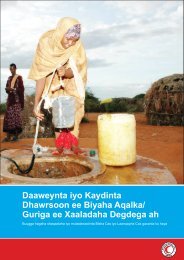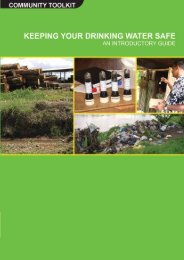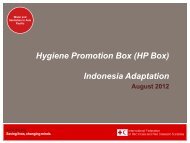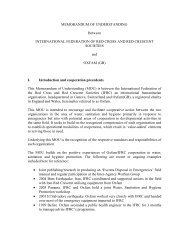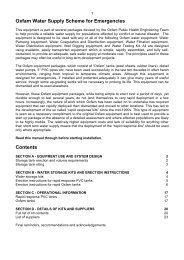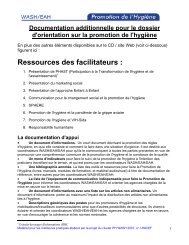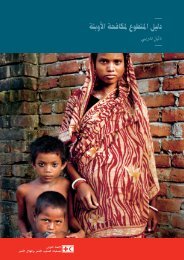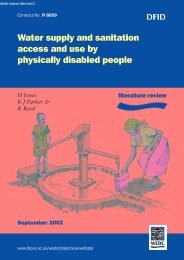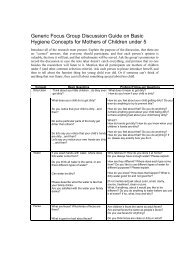Hygiene Promotion - IRC International Water and Sanitation Centre
Hygiene Promotion - IRC International Water and Sanitation Centre
Hygiene Promotion - IRC International Water and Sanitation Centre
Create successful ePaper yourself
Turn your PDF publications into a flip-book with our unique Google optimized e-Paper software.
Appendix 9. Participatory tools <strong>and</strong> techniquesThere are lots of participatory tools/techniques available to help guide the process. Threeof the most popular approaches (overlapping rather than competing) are:PHAST (Participatory <strong>Hygiene</strong> <strong>and</strong> <strong>Sanitation</strong> Transformation) developed in Eastern <strong>and</strong>Southern Africa in the mid-late 1990s <strong>and</strong> specifically focused on toolkits for programmesto bring about behavioural change in hygiene <strong>and</strong> sanitation.SARAR (Self-esteem, Associative strength, Resourcefulness, Action planning,Responsibility) stimulates involvement in community-based activities of all kinds, not onlyby the more prestigious <strong>and</strong> articulate participants (such as community leaders or seniorstaff), but also by the less powerful, including non-literate community members.PRA (Participatory Rural Appraisal) a generalized description which covers a wide range oftechniques especially aimed at involving communities in decision-making <strong>and</strong> selfassessment<strong>and</strong> in the development of stakeholder partnerships.Other useful tools or activities are:A focus group discussionA skilled facilitator assembles representative groups from the community <strong>and</strong> creates anatmosphere where individuals feel free to express opinions openly on topics such as theenvironmental problems caused by excreta <strong>and</strong> how they can be mitigated. The facilitatoris armed with key questions, but the conclusions emerge from the groups’ opendiscussions <strong>and</strong> lead to ideas for action. Focus groups are helpful in the formativeresearch phase, identifying the target practices <strong>and</strong> key messages for the different groups.A neighbourhood social mapIn open meetings, local women <strong>and</strong> men have made a social map of their whole settlement(in small communities) or neighbourhood (in large communities). The techniques useddepend on the levels of development. People draw in the soil, they fingerpaint or draw onpaper, or use cut-<strong>and</strong> paste techniques. Techniques that require implements such as pens<strong>and</strong> scissors are less suitable for people without or with low literacy, often the women <strong>and</strong>the poor. Mapping can be used for many things, from what kind of families have <strong>and</strong> usewhat types of latrines, water sources or hygiene related skills to whether women <strong>and</strong> menfrom different classes <strong>and</strong> sections have equal access to education <strong>and</strong> training.A transect walkA local team of women <strong>and</strong> men systematically walks through a cross-section theirsettlement, reviews good <strong>and</strong> bad situations <strong>and</strong> note these in their cross-section diagram.<strong>IRC</strong> <strong>International</strong> <strong>Water</strong> <strong>and</strong> <strong>Sanitation</strong> <strong>Centre</strong> 85



